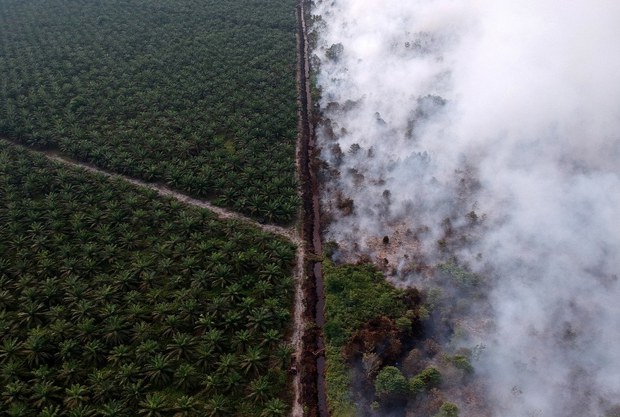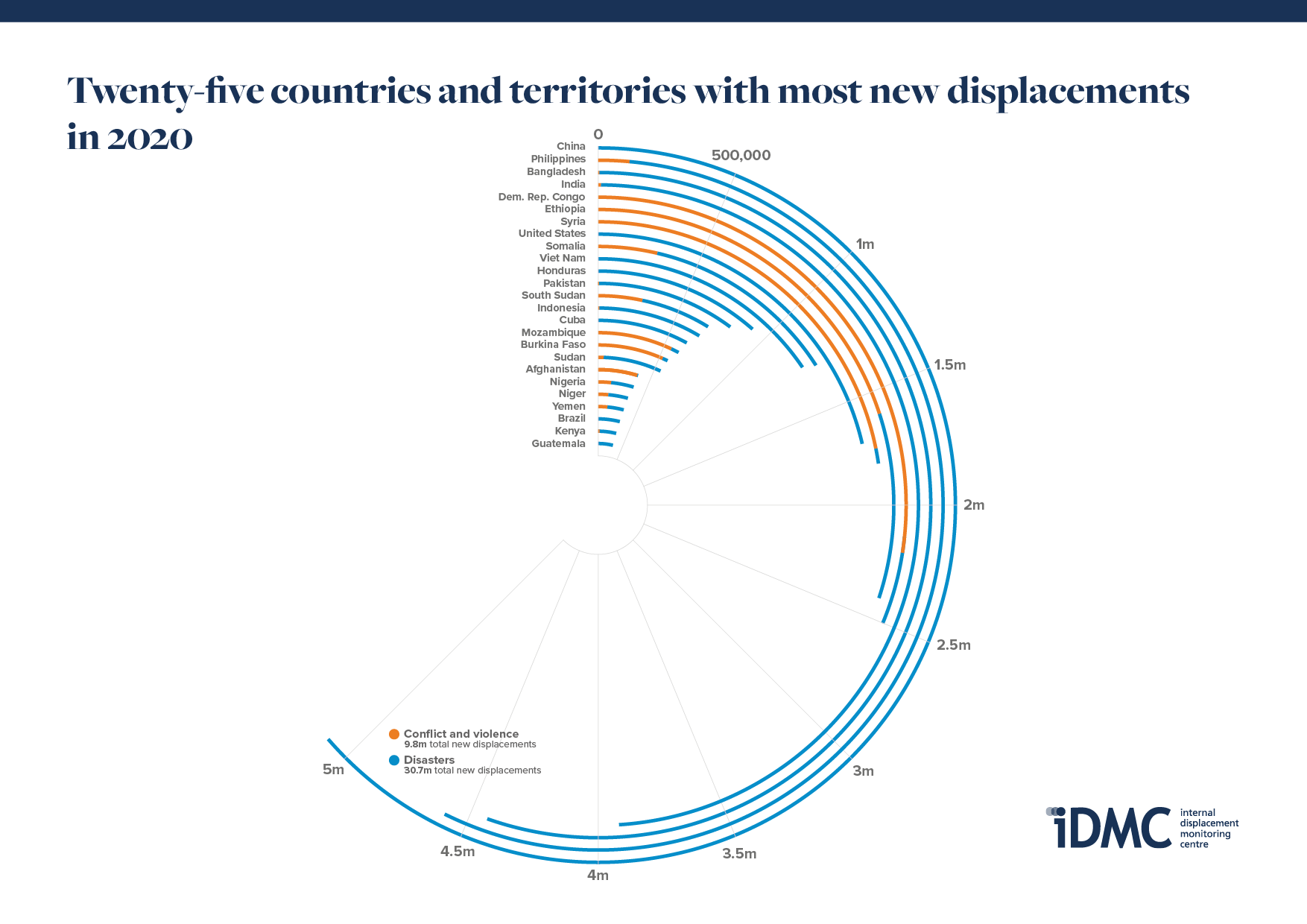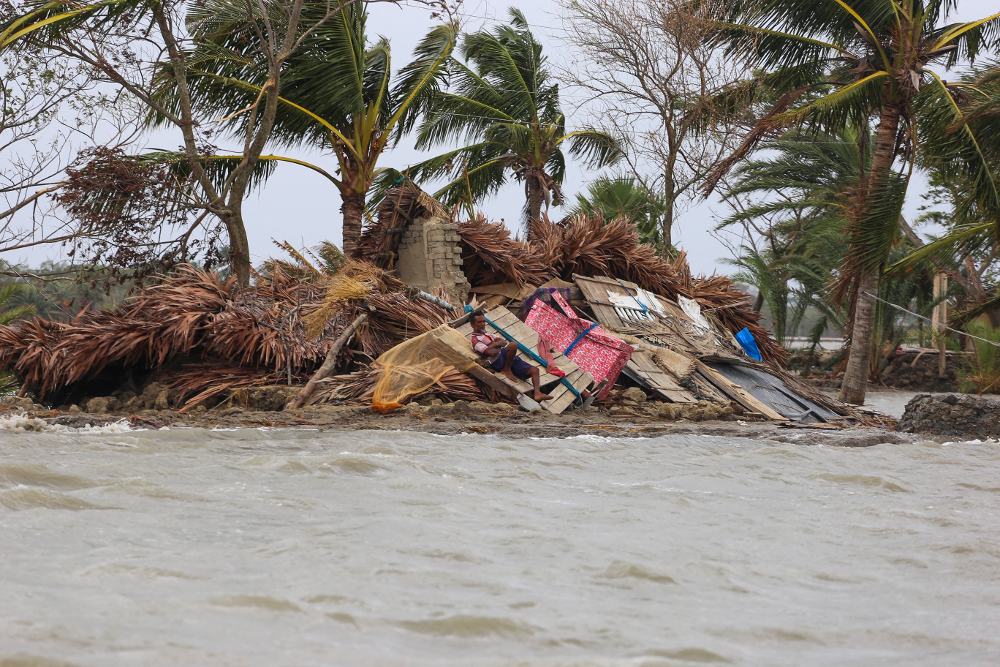Study: Climate Disasters Displaced 8M People Internally in Philippines, Bangladesh in 2020
2021.05.20
Washington
 A forest fire burns next to a palm-oil plantation, in this aerial photo taken above Kumpeh Ulu, a district in Muarojambi, Indonesia, July 30, 2019.
A forest fire burns next to a palm-oil plantation, in this aerial photo taken above Kumpeh Ulu, a district in Muarojambi, Indonesia, July 30, 2019.
In a year when millions were forced to flee their homes due to climate-fueled natural disasters, the Philippines and Bangladesh were among the most affected countries in 2020, according to a report published Thursday by a group that monitors internal displacements of people worldwide.
More than 40 million people around the world were displaced last year within their nations’ borders by natural disasters or conflict despite many governments imposing lockdowns or movement restrictions due to a global pandemic, the Geneva-based Internal Displacement Monitoring Centre (IDMC) reported.
“Weather-related events were responsible for 98 percent of all disaster displacement recorded in 2020,” the group said in its annual Global Report on Internal Displacement (GRID).
“Most disaster displacements were the result of tropical storms and floods in East Asia and the Pacific and South Asia. China, the Philippines and Bangladesh each recorded more than four million new displacements, many of them pre-emptive evacuations.”
And, according to a report published earlier this week by Forest Trends, a Washington-based conservation NGO, Southeast Asia suffers terribly from the effects of climate change, with Indonesia and Malaysia contributing to climate erosion.
Between 2013 and 2019, Indonesia, the region’s largest country and a top producer of palm oil, was responsible for 20 percent of the world’s illegal razing of tropical forests through agricultural clear-cutting fires that increased carbon emissions in the region, the study by Forest Trends said.
Tropical cyclones, typhoons, monsoon rains and floods hit highly exposed areas that are home to millions of people in South and Southeast, according to the report by IDMC.
“It’s shocking that someone was forced to flee their home inside their own country every single second last year,” said Jan Egeland, secretary general of the Norwegian Refugee Council, which IDMC is a part of.
IDMC’s “Grid 2021” report tracked displacement from extreme climate events as well as war and conflict.
The year “2020 was, for many of us, a year of lockdowns and travel restrictions but not so for the millions who fled for their lives because of conflict, violence and disasters,” Egeland said.
“[W]e have documented that, 40 million times [last year], a man, a woman, or a child have been forced out of their homes because of disaster or conflict. It’s the worst figures in a decade.”

As the United States Geological Survey noted, climate change plays a role in exacerbating disasters.
“With increasing global surface temperatures the possibility of more droughts and increased intensity of storms will likely occur. As more water vapor is evaporated into the atmosphere it becomes fuel for more powerful storms to develop,” the U.S. government agency said.
“More heat in the atmosphere and warmer ocean surface temperatures can lead to increased wind speeds in tropical storms.”
Typhoon Vongfong, also known as Ambo, the first tropical cyclone to hit the Philippines in 2020, caused more than 298,000 displacements, mostly in the form of pre-emptive evacuations.
Later that year, Typhoons Goni and Vamco cause more than 3 million displacements in the Philippines and Vietnam in October and November, according to IDMC.
‘Proactive measures that build resilience’
Elsewhere, South Asia accounted for almost a third of the world’s new disaster displacements in 2020.
Around 9.2 million displacements were recorded in the region, which IDMC said was an above-average figure for the second year in a row.
A big contributor was Cyclone Amphan, which triggered nearly 2.5 million displacements in Bangladesh alone, of a total 5 million in the region.
“It damaged and destroyed homes and other infrastructure and left hundreds of thousands of people homeless,” IDMC said.
“The damage it did to embankments led to the flooding of homes, farms and fields that have been underwater ever since,” IDMC said.
Powerful storms and cyclones have become more frequent in South Asia due to warmer temperatures in the Indian Ocean. When combined with rising sea levels, the phenomena cause even more devastating storm surges that flood larger and larger areas, IDMC said, adding that Cyclone Amphan illustrated the problem.
“The need for more inclusive and proactive measures that build the resilience of those regularly exposed to similar hazards is also clear,” IDMC said.

Lush forests turned into palm-oil plantations
In Southeast Asia, palm oil, soy and cattle products drive global figures of illegal deforestation, according to the report by Forest Trends.
Most of the forest clearing took place in in Brazil and Indonesia during 2013-2019, the years the report studied.
Southeast Asia has 80 percent of the world’s palm oil plantations, and many of Indonesia’s and Malaysia’s palm oil, paper, and pulp plantations are built on illegally razed tropical forests, the NGO said.
“The criminal destruction of rainforests for commodities such as beef, chocolate, soy and palm oil knocks down 4.5 million hectares and releases 2.7 gigatons of emissions a year,” said a press release which accompanied the report by Forest Trends, titled “Illicit Harvest, Complicit Goods: The State of Illegal Deforestation for Agriculture.”
Palm oil is the biggest forest risk commodity in Asia-Pacific, said the study, and Indonesia led other Southeast Asian nations in forest-clearing, the report said.
“The global average proportion of illegality for palm oil (59 percent) is constrained by low data availability in Malaysia. …These [forest] losses have been tied to billions of dollars in economic losses, such as those resulting from the El Niño drought-linked forest fires that created massive haze events.”
In Indonesia, companies and farmers clear land by burning their vegetation. The fires often spread to protected forestlands. And the resulting giant blazes emit greenhouse gases and cause a heavy haze that crosses national boundaries and engulfs other Southeast Asian countries.
While the findings of Forest Trends seem dire, there is hope, as Indonesia has successfully reduced its deforestation every year since a peak in 2016, the report said.
Indonesia’s deforestation rate hit a historic low in 2020, according to the country’s Environment and Forestry Ministry.
The government attributed the reduction to policies such as a moratorium on licenses for new palm oil plantations, and a ban on clearing primary forests and peatlands.
But other experts have noted that drop was likely due to more rains, falling oil palm prices, and an economic slowdown as a result of the COVID-19 pandemic.








